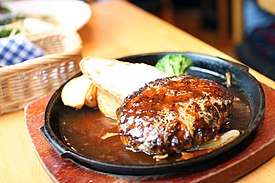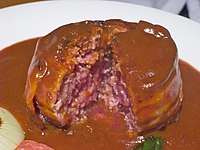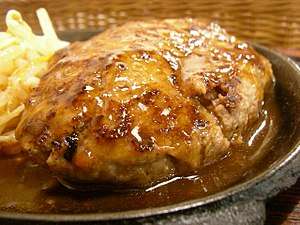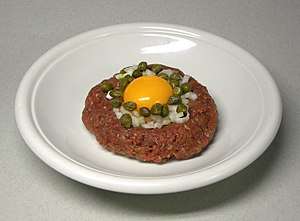Hamburg steak
Hamburg steak is a patty of ground beef. Made popular worldwide by migrating Germans, it became a mainstream dish around the start of the 19th century. It is similar to Salisbury steak.
 A Hamburg steak | |
| Place of origin | Germany |
|---|---|
| Main ingredients | Beef |
History
.jpg)
Prior to the disputed introduction of the hamburger in the United States, similar foods already existed in the culinary tradition of Europe. The Apicius cookbook, a collection of ancient Roman recipes that may date to the early fourth century, details a preparation of beef called isicia omentata; served as a baked patty in which beef is mixed with pine kernels, black and green peppercorns, and white wine, isicia omentata may be the earliest precursor to the hamburger.[1]
When Genghis Khan's grandson Kublai Khan (1215–1294) invaded Moscow, his warriors and he introduced minced horsemeat to the Muscovites. This was later called steak tartare.[2] The city-states of what is now Germany took to this ground meat product and created many of their own dishes by adding capers, onions, and even caviar to the blend and selling it on the streets.[3] It is not known when the first restaurant recipe for steak tartare appeared.[4] While not providing a clear name, the first description of steak tartare was given by Jules Verne in 1875 in his novel Michael Strogoff. Certain similarities exist between steak tartare and the German dishes Labskaus and Mett. Other similar raw, chopped meats appeared in the 20th century, such as the Italian carpaccio, which itself was invented in 1950 at Harry's Bar in Venice.[5] Similarly, one of the oldest references to a Hamburgh sausage appeared in 1763 in the cookbook entitled Art of Cookery, Made Plain and Easy by Hannah Glasse (1708–1770). Hamburgh sausage is made with minced meat and a variety of spices, including nutmeg, cloves, black pepper, garlic, and salt, and is typically served with toast. A wide variety of traditional European dishes is also made with minced meat, such as meatloaf,[6] the Serbian pljeskavica, the Arab kofta, and Swedish meatballs.
While ground beef was used by various cultures in Europe and Central Asia, the hamburger steak's other vital ingredient, bread, has a different history. Bread had always been part of the development of many types of foods, including sauces such as those described by Marie-Antoine Carême in his compendium entitled L'art de la cuisine française au XIXe siècle. The word "sandwich" was not recorded until the 18th century. Many cultures claim invention of the sandwich, but it was given its name around the year 1765 in honor of the English aristocrat John Montagu, 4th Earl of Sandwich, who preferred to eat sandwiches so he could play cards without soiling his fingers.[7] However, Elizabeth Leslie Cook did not include a sandwich recipe in her cookbook until 1840, when it appeared in the local cuisine of the United States.[8]
Hamburg and its port

Minced meat was a delicacy in medieval cuisine, red meat usually being restricted to the higher classes.[9] Very little mincing was done by medieval butchers or recorded in the cookbooks of the time, perhaps because it was not part of the sausage-making processes that preserve meat. Russian ships brought recipes for steak tartare to the port of Hamburg during the 17th century,[10] a time when the presence of Russian residents there was so great that it was nicknamed "the Russian port." Trade within the Hanseatic League between the 13th and 17th centuries made this port one of the largest in Europe, its commercial importance being further heightened as it became vital to early transatlantic voyages during the age of steam. In the period of European colonization of the Americas, immigrants to this port were a "bridge" between old European recipes and the future development of the hamburger in the United States.[11]
During the first half of the 19th century, most of the northern European emigrants who traveled to the New World embarked on their transatlantic voyages from Hamburg. The German shipping company Hamburg America Line, also known as the Hamburg Amerikanische Packetfahrt Actien-Gesellschaft, was involved in Atlantic transport for almost a century.[12] The company began operations in 1847 and employed many German immigrants, many of them fleeing the revolutions of 1848–9. New York City was the most common destination for ships traveling from Hamburg, and various restaurants in the city began offering the Hamburg-style steak to attract German sailors. The steak frequently appeared on the menu as a "Hamburg-style American fillet",[13][14] or even beefsteak à Hambourgeoise. Early American preparations of minced beef were, therefore, made to fit the tastes of European immigrants, evoking memories of the port of Hamburg and the world they left behind.[12]
Hamburg steak
In the late 19th century, the Hamburg steak became popular on the menus of many restaurants in the port of New York. This kind of fillet was beef minced by hand, lightly salted, often smoked, and usually served raw in a dish along with onions and bread crumbs.[15][16] The oldest document that refers to the Hamburg steak is a Delmonico's Restaurant menu from 1873 that offered customers an 11-cent plate of Hamburg steak that had been developed by American chef Charles Ranhofer (1836–1899). This price was high for the time, twice the price of a simple fillet of beef steak.[14][17] By the end of the century, the Hamburg steak was gaining popularity because of its ease of preparation decreasing cost. This is evident from its detailed description in some of the most popular cookbooks of the day.[6] Documents show that this preparation style was used by 1887 in some US restaurants and was also used for feeding patients in hospitals; the Hamburg steak was served raw or lightly cooked and was accompanied by a raw egg.[18]
The menus of many American restaurants during the 19th century included a Hamburg beefsteak that was often sold for breakfast.[19] A variant of Hamburg steak is Salisbury steak, which is usually served with a gravy similar in texture to brown sauce. Invented by Dr. James Salisbury (1823–1905), the term Salisbury steak has been used in the United States since 1897.[20] Nowadays, in the city of Hamburg, as well as in parts of northern Germany, this type of dish is called Frikadelle, Frikandelle, or Bulette, which is similar to the meatball. The term hamburger steak was replaced by hamburger by 1930, which has in turn been somewhat displaced by the simpler term, burger.[21] The latter term is now commonly used as a suffix to create new words for different variants of the hamburger, including cheeseburger, porkburger, baconburger, and mooseburger. Other foods have names derived from German cities that are shortened in different ways in American English. An example is the frankfurter, often abbreviated as "frank".[21]
A distinction is sometimes made between the terms Hamburg steak and hamburger, the former referring to just a beef patty made a certain way, while the hamburger is a sandwich-like dish, i.e., a Hamburg steak sandwich comprising the patty, a bun, and often other ingredients.[22]
 Close-up view of a Hamburg steak
Close-up view of a Hamburg steak
Preparation
Hamburg steak is made from beef which is finely chopped, ground (American English), or minced (British English).[23] Seasoning, egg, breadcrumb, onion and milk may be combined with the meat,[23] which is then formed into patties and cooked, by frying, roasting, or smoking.[24]
Haute cuisine
Hamburg steak is listed by Escoffier as a classic dish in haute cuisine.[25]
Around the world

Hamburg (ハンバーグ, hanbāgu, Hamburg steak)[26] is a popular dish in Japan. It is made from ground meat with finely chopped onion, egg, and breadcrumbs flavored with various spices, and made into a flat, circular shape about 1 cm thick and 10 to 15 cm in diameter. Many restaurants specialize in various styles of hamburg steak.[27] Some variations include hanbāgu topped with cheese (チーズハンバーグ, or chīzuhanbāgu), hanbāgu with Japanese curry, and Italian hanbāgu (with tomato sauce rather than gravy).[28]
Hamburg steak became popular during the 1960s as a more affordable way to serve otherwise costly meat. Magazines regularly printed the recipe during that decade, elevating it to a staple dish in Japanese culture. In Japan, the dish dates back to the Meiji period and is believed to have been first served in Yokohama, which was one of the first ports opened to foreigners. Since the 1980s, vacuum-packed hamburgers are sold with sauce already added, and these are widely used in box lunches (bento). Frozen hamburgers are popular, as well, and are often served in fast-food style restaurants.
In Hawaii, hamburger steak is very similar to the Japanese hanbāgu. It consists of burger patty with brown gravy. It is usually served with macaroni salad and rice in a plate lunch. Also, another variety includes an egg, which is called loco moco.
In Finland, the dish is called jauhelihapihvi ("ground meat steak") and is prepared and served like the meatball: pan-fried, and served with potatoes and brown sauce.
See also
References
- Pantke, Micaela. "Antique Roman Dishes - Collection". Carnegie Mellon School of Computer Science Recipe Archive. Carnegie Mellon University. Retrieved 26 September 2014.
- Turnbull, Stephen (2003). Mongol Warrior 1200–1350 (1st ed.). London: Osprey Publishing. p. 30. ISBN 1-84176-583-X.
- Ronald McDonald's The Complete Hamburger 1998
- Prosper Montagné (1938), "Larousse gastronomique"
- Cipriani, Arrigo (1996). Harry's Bar: The Life and Times of the Legendary Venice Landmark. New York: Arcade. ISBN 1-55970-259-1.
- Farmer, Fannie Merritt (1896). Boston Cooking-School Cookbook. Gramercy (ed. 1997). ISBN 0-517-18678-0.
- Rodger, N. A. M. (1994). The Insatiable Earl: A Life of John Montagu, Fourth Earl of Sandwich 1718–1792 (1st ed.). W W Norton & Co Inc. p. 480. ISBN 0-393-03587-5.
- Leslie, Elizabeth (1840). Directions for Cookery, in its Various Branches. E. L. Carey & A. Hart. Retrieved 2008-12-24.
- Alan Beardsworth, Teresa Keil, (1997), "Sociology on the Menu: An Invitation to the Study of Food and Society", Ed. Routledge
- Clapp, Edwin J. (1952). The Port of Hamburg (1st ed.). Yale University Press.
- Osborn Cummings, Richard (June 1970). The American and His Food (The Rise of urban America) (1st ed.). Ayer Co Pub. ISBN 0-405-02445-2.
- Moch, Leslie Page (2003). Moving Europeans: Migration in Western Europe Since 1650 (2nd ed.). Indiana University Press. ISBN 0-253-21595-1.
- Ranhofer, Charles (1894). The Epicurean: A Complete Treatise of Analytical & Practical Studies (1st ed.). B00085H6PE.
- Ozersky, Josh (2008). The Hamburger: A History (Icons of America) (1st ed.). London: Yale University Press. ISBN 0-300-11758-2.
- 1802, Oxford English Dictionary
- Fitzgibbon, Theodora (January 1976). The Food of the Western World: An Encyclopedia of Food from North America and Europe (1st ed.). London: Random House Inc. ISBN 0-8129-0427-3.
- Food in American History, Part 6 – Beef (Part 1): Reconstruction and Growth into the 20th Century (1865–1910), by Louis E. Grivetti, PhD, Jan L. Corlett, PhD, Bertram M. Gordon, PhD, and Cassius T. Lockett, PhD
- Murrey, Thomas Jefferson (1887). "Eating Before Sleeping". Cookery for Invalids (PDF) (1st ed.). New York City: White Stokes & Allen. pp. 30–33. Retrieved 2013-12-24.
- Roger M. Grace, "Old Menus Tell the History of Hamburgers", Los Angeles, CA Metropolitan New-Enterprise newspaper
- "Salisbury steak". Merriam-Webster Online. Retrieved 2009-01-28.
- Merriam-Webster (1995). The Merriam-Webster New Book of Word Histories. I. Merriam-Webster. pp. 210–211. ISBN 0-87779-603-3.
- McWilliams 2012, p. 122.
- Hunt, Caroline Louisa (1910). Economical use of meat in the home. Department of Agriculture (United States). pp. 33–.
- Blumenthal, Heston (2010). In Search of Total Perfection. Bloomsbury. pp. 195–. ISBN 9781408802441.
- Le Guide Culinaire by Auguste Escoffier, 1903
- "Japanese Hamburg Steak".
- Murakami, Haruki. The Elephant Vanishes, p. 188-194.
- ja:ハンバーグ
